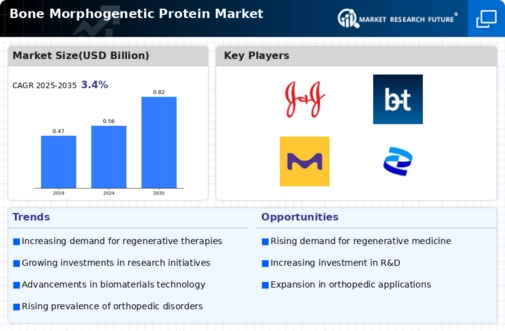Leading market players are investing heavily in research and development to expand their product lines, which will help the Bone Morphogenetic Protein market grow even more. Market participants are also undertaking a variety of strategic activities to expand their global footprint, with important market developments including new product launches, contractual agreements, mergers and acquisitions, higher investments, and collaboration with other organizations. To expand and survive in a more competitive and rising market climate, the Bone Morphogenetic Protein industry must offer cost-effective items.
Manufacturing locally to minimize operational costs is one of the key business tactics used by manufacturers in the global Bone Morphogenetic Protein industry to benefit clients and increase the market sector. In recent years, the Bone Morphogenetic Protein industry has offered some of the most significant advantages to the field of orthopedic surgery and bone regeneration.
Major players in the Bone Morphogenetic Protein Market, including Johnson & Johnson, Ember Therapeutics Inc., Integra Lifesciences Holdings Corporation, Medtronic PLC, Bio-Techne (R&D Systems, Inc.), Merck KGaA, Pfizer, Inc., Stryker Corporation, Thermo Fischer Scientific, Zimmer Biomet Holdings, Inc are attempting to increase market demand by investing in research and development operations.
Johnson & Johnson engages in the research, development, manufacturing, and sale of pharmaceutical products and medical devices through its various operating companies. Its pharmaceutical offerings encompass treatments for immune disorders, cancer, neurological conditions, infectious diseases, cardiovascular issues, and metabolic disorders. In the realm of medical devices, J&J provides solutions for cardiovascular, orthopedic, neurovascular, general surgery, and vision care applications.
The company distributes its pharmaceutical and medical products to a wide range of entities, including retailers, wholesalers, healthcare professionals, and hospitals across different regions, including the US, Europe, Asia-Pacific, Africa, Latin America, and the Western Hemisphere (excluding the US). Headquartered in New Brunswick, New Jersey, USA, J&J maintains a global presence.
Pfizer is involved in the discovery, development, manufacturing, and commercialization of biopharmaceuticals across various therapeutic areas. Its product portfolio encompasses treatments for cardiovascular and metabolic disorders, pain management, women's health, cancer, inflammation, immune-related conditions, and rare diseases. Additionally, Pfizer offers sterile injectable pharmaceuticals, biosimilars, active pharmaceutical ingredients (APIs), and contract manufacturing services.
The company distributes its products through a wide network, including wholesalers, retailers, hospitals, individual provider offices, clinics, government agencies, and pharmacies. With major manufacturing facilities located in India, China, Japan, Ireland, Italy, Belgium, Germany, Singapore, and the US, Pfizer serves markets across North America, South America, Asia-Pacific, Australia, Europe, Africa, and the Middle East. Headquartered in New York, USA, Pfizer operates on a global scale.





